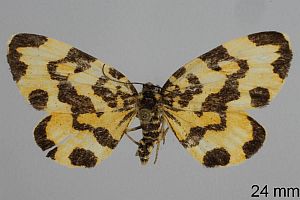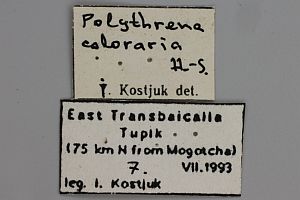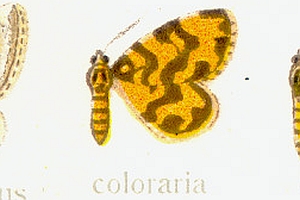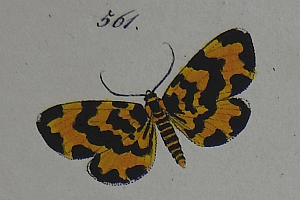

 +2Kontinente:EUAS
+2Kontinente:EUAS2. Diagnose
2.1. Männchen
2.2. Erstbeschreibung
2.3. Darin indizierte Abbildung
Die Indikation „Sppl. 562“ [recte: 561] ist offensichtlich ein Druckfehler.
3. Biologie
3.1. Falter
Leinonen et al. (2006: 60) meldeten: "Polythrena coloraria is a day-active moth that makes short flights in sunny weather. While sitting on leaves, it is clearly visible; the adult has orange-yellow wings with black marks (Fig. 13). When the weather gets cloudy, the moths rapidly hide. Once we observed a swarming flight around the crowns of trees at about eight metres. N. Kutenkova has found this species on wings between the 6th of June and the 13th of July."
3.2. Habitat
Leinonen et al. (2006: 61) schildern: "To our knowledge, there are four separate sites of occurrence of this species around Kivach. All of them are rather close to a brooklet. All sites are dominated by Norwegian spruce (Picea abies) and, regarding the bush layer, black currant. Other characteristic trees are Tilia cordata, Populus tremula, Betula pubescens [...] Thus,the preferred habitat seems to be a lush brookside grove (Fig 14)."
3.3. Nahrung der Raupe
- [Grossulariaceae:] Ribes nigrum (Schwarze Johannisbeere)
Leinonen et al. (2003) meldeten aus Russisch-Karelien Eifunde (3 einzelne Eier) an Blattunterseiten von Ribes nigrum; mit dieser Pflanze gelang auch die Raupenzucht. Leinonen et al. (2006) lieferten weitere Details; im Abstract heißt es diesmal: "Investigations were made upon the biology and habitat demands of the larvae and adults of Polythrena coloraria in the Kivach nature reserve in the Republic of Karelia, Russia, close to the eastern border of Finland. In the laboratory females laid eggs only on Ribes nigrum, although other plants were also available. Eggs were found in the field under the leaves of this plant, too. Instead larvae were not found in the field. In the laboratory they did not eat any other plants offered. In addition, the male and female genitalia and larval morphology are described. [...] A parasitoid wasp Telenomus acarnas (Hymenoptera, Scelionidae, Telenominae) is reported from the eggs of P. coloraria. It seems to be the first host record for this parasitoid wasp."
(Autor: Erwin Rennwald)
4. Weitere Informationen
4.1. Andere Kombinationen
- Minoa coloraria Herrich-Schäffer, 1855 [Originalkombination]
4.2. Unterarten
- Polythrena coloraria pallida (Djakonov, 1929)
4.3. Verbreitung
Nach Hausmann & Viidalepp (2012) ist die Art von Nordchina durch den russischen Taigagürtel bis in den Norden des europäischen Teils von Russland verbreitet, wobei aus Europa nur ganz wenige Nachweise vorliegen. Ein isolierter Fundpunkt aus dem 19. Jahrhundert betrifft Karelien.
Leinonen et al. (2003: 24) schrieben in ihrem englischen Abstract unter der Überschrift "Polythrena coloraria (Lepidoptera, Geometridae), a pearl among the geometrid moths of Eastern Russian Karelia" dazu: "A short history is given of the findings of the Geometrid moth Polythrena coloraria in Eastern Russian Karelia. It has been first recorded there as early as in the middle of 1800's. [...] The known sites of occurence are only 120 kilometers away from the Finnish border. Therefore this species is worth seeking in suitable sites in Eastern Finland." In Finnland blieben Funde aber aus.
(Autor: Erwin Rennwald)
4.4. Publikationsjahr der Erstbeschreibung
Wir folgen den detaillierten Datierungs-Angaben von Heppner (1982). Die Tafel Geometrides 91 ist darin nicht aufgeführt.
4.5. Literatur
- Hausmann, A. & J. Viidalepp (2012): The Geometrid Moths of Europe. Volume 3. - 743 S.; Vester Skerninge, Dänemark (Apollo Books).
- Heppner, J. B. (1982): Dates of selected Lepidoptera literature for the western hemisphere fauna. — Journal of the Lepidopterologists' Society 36 (2): 87-111.
- Erstbeschreibung: Herrich-Schäffer, G. A. W. (1843-1856): Systematische Bearbeitung der Schmetterlinge von Europa, zugleich als Text, Revision und Supplement zu Jakob Hübner's Sammlung europäischer Schmetterlinge. Sechster und letzter Band: Schlusswort [4 pp., unpaginiert]; Macrolepidoptera I-XVIII, pl. I-XXII; Microlepidoptera I-VIII, pl. I-XIV; Nachtrag zum ersten Bande 1-38, Nachtrag zum zweiten Bande 39-61, Nachtrag zum dritten Bande 62-80, [Nachtrag ohne Titel] 81-133; Weitere Nachträge zum dritten Band 133-139, Nachträge zum vierten Band 140-161, Nachträge zum fünften Band 161-166, Zweiter Nachtrag zum ersten und zweiten Bande 167-178; Systema Lepidopterorum Europae 1-72; Index 1-48. Regensburg (G. J. Manz).
- Leinonen, R., Ahola, M., Vikberg, V. & J. Itämies (2003): Tiikerimittari Polythrena coloraria (Herrich-Schäffer, 1885) (Lepidoptera, Geometridae), Itä-Karjalan helmi. Polythrena coloraria (Lepidoptera, Geometridae), a pearl among the geometrid moths of Eastern Russian Karelia). — Baptria, 28 (3): 24-27. [PDF (ganzes Heft) auf perhostutkijainseura.fi]
- Falter-, Raupen- und Genitalbilder und -zeichnungen: Leinonen, R., Kutenkova, N., Ahola, M., Itämies, J. & V. Vikberg (2006): The ecology, genitalia and larval morphology of Polythrena coloraria Herrich-Schäffer, 1855 (Lepidoptera: Geometridae), with records of its egg parasitoid Telenomus acarnas Kozlov & Kononova, 1977 (Hymenoptera: Scelionidae). — Entomologica Fennica 17 (1): 56-64. [PDF auf journal.fi]
- Seitz, A. (Hrsg.) (1909-1914). Die Gross-Schmetterlinge der Erde. Band 4: I-V, 1-479, I-IV, pl. 1-25. Stuttgart (Alfred Kernen Verlag).









